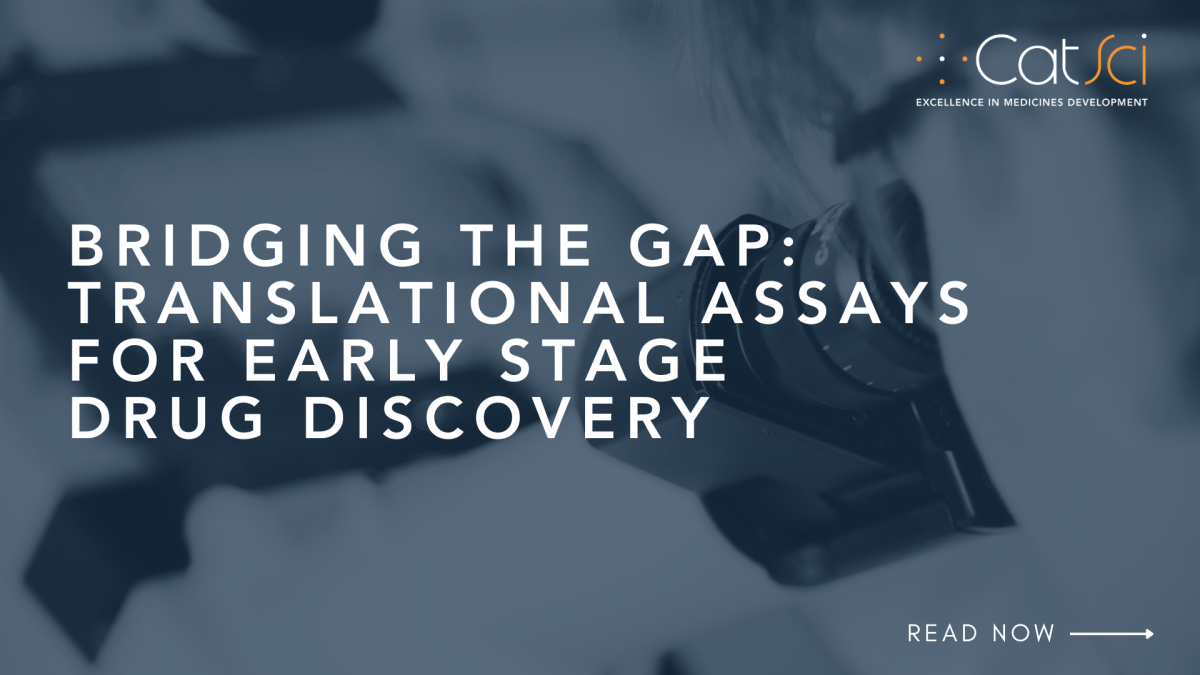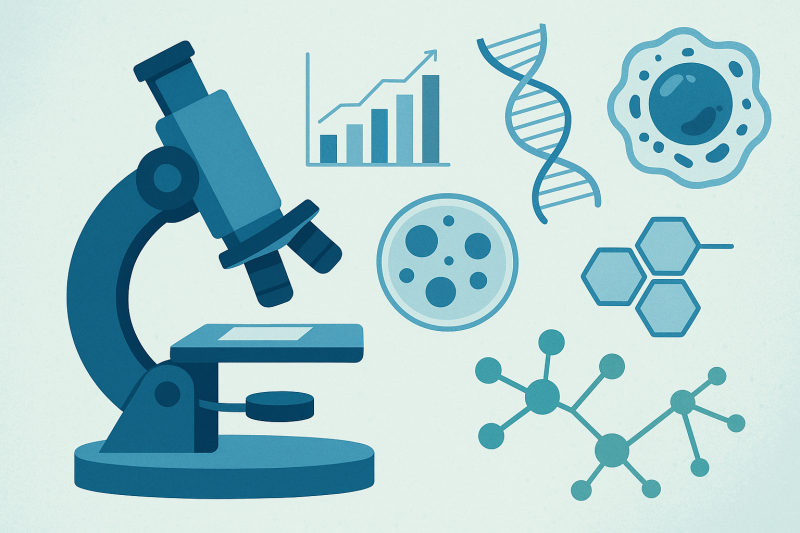
Bridging the Gap: Translational Assays for Early Stage Drug Discovery
Early stage drug discovery only works when what we measure in the lab correlates to what happens in patients; that’s why it is crucial to bridge the gap between translational assays from lab to clinic. In this article, we will explore the importance of building translational assay cascades that prioritise human relevance – starting with robust cell-based systems, incorporating patient derived material where possible, and the dilemma of in vivo models. This piece will also explore the limits of purely biochemical readouts, the importance of context (microenvironment, communication, phenotype, etc.) and also the emerging tools that will help drug discovery teams generate decision-ready data that better predicts clinical outcomes.
Why Translation Matters in Early Stage Drug Discovery
When it comes to the success or failure of a drug discovery programme, target validation and the translation of target activity to disease are highly significant factors. For example, whether the bioassay readouts generated in the lab reflect what is seen clinically, confirming that modulating the target does indeed inhibit disease progression.
While both are critical aspects of the process, this thought piece focuses on translational biology and recapitulation of the disease and target in a well plate or in-vivo. To begin, it is important to consider the definition of “a bioassay”. A bioassay must be robust, reliable, consistent, and governed by strong quality-control parameters.
The Practicalities of Starting in Cells
Most bioassays start in a microwell plate format. A classical drug discovery cascade begins with a biochemical or biophysical assay that examines the binding of small molecules, peptides, or antibodies to the binding site of the target. Arguably, while this starting point is logical, there is not always a reasonable – if any – correlation between a compound’s effect in a biochemical assay, and that seen in a cell-based assay on the same target; most correlations are poor or non-existent. The absence of the target in its native state, coupled with the absence of a penetrable cell membrane, are two likely contributing factors influencing the lack of correlation.
Beginning a programme with a cell-based assay is challenging, but offers some advantages. Typically, the target of interest is cloned into a “working environment” such as an immortalised cell of human origin (e.g. HEK cells – Human Embryonic Kidney). The activity of the protein is then coupled to a means of measuring target activity when a ligand is bound. Interestingly, in a lot of programmes we have worked on, the objective has been to inhibit the protein’s activity: generally, the native ligand activates the protein, resulting in some sort of detectable readout with defined binding parameters. Compounds are used to inhibit the binding of the native ligand to the protein. These initial cell-based assays are valuable for medicinal chemistry support, enabling the ranking of compounds to each other and providing significant insights into pharmacophore design. However, they are somewhat sterile and isolationist: the protein, although expressed in a human cell background, is not performing within its native environment, and certainly not within a disease environment in which other pressures, such as disease-induced differences in kinetics, pH and solubility, enter the equation. Pharmacologists and cell biologists also overlook, or even completely ignore, communication association with neighbouring cells, let alone messages transmitted through circulatory proteins and exosomes. Having spent 18 to 24 months getting to this point, scientists often transition their programmes and research into animal models (where available), or human derived patient cells, either “normal” or “diseased”.

The Animal-Model Dilemma
“An animal is not a human!” That reminder sits at the core of translational biology. Many human diseases are not translatable to rodents, and while non-human primate studies can offer closer biology, they are costly and unethical. In central nervous system/pain and respiratory/ inflammatory research within Large Pharma, there has been frequent frustration of setting up “models” of human disease in an in-vivo setting that looked compelling, only to later find that these models failed to recapitulate the disease – or worse, exposed that the target or mechanism is wrong once human data emerged.
The Promise of Patient-Derived Cells
A source of optimism can be found in patient derived cells. Assuming ethical approval can be obtained, then the use of disease cells and tissue from the patient provides a powerful, human-relevant starting point. In the field of inflammation and oncology, collaborations with local hospitals can allow rapid access to human blood or resected material, enabling assays that reflect the true disease state.
Immunology and Flow Cytometry
For immune cell studies, the ability to collect whole blood and isolate cell types has given this field an advantage over others. Sub fraction blood to PBMC’s, Th1 and Th2 cells, B-cells etc has enabled sub-populations of control and cells from diseased patients to be isolated in a relatively straightforward and cost-effective manner. . Combining Flow Cytometry with chemokine and cytokine detection and measurement lets a disease phenotype emerge in the appropriate cellular background, supporting rigorous scientific investigation of the target. . However, it is arguable that studying immune responses in the absence of the immune system as a whole has its drawbacks and can miss context; recreating the relevant milieu of “kine” factors at relevant concentrations, both local and non-localised, are required to distinguish normal from abnormal.
Genotype vs. Phenotype in Tumour Biology
For oncology studies, cancer cells within resected tissue are heterogenous, not homogenous; not all cells have the same phenotype, but many have the same genotype. The difference between genotype and phenotype is interesting: a cell’s genotype has been genetically passed down but may have mutated; The cell’s phenotype is a consequence of the conditions it finds itself within, and the signals it receives from the environment, for example, its neighbours, through paracrine interactions and more holistically, its endocrine and exosome environment. Understanding this divergence is central to building assays that truly translate.
iPSCs: Toward Human-Relevant, Homogenous Models
It is possible that more homogenous populations of human cells may be derived from Inducible Human Pluripotent Stem Cells (iPSC’s). These offer some promise, particularly those isolated from disease patients. As the field of stem cell differentiation develops, scientists can now differentiate iPSC’s into several terminally differentiated phenotypes, including hepatic cells (hepatocytes, Kufner cells, liver fibroblasts, etc) in addition to central nervous system cell types, including neurones and glial/structural cells.
Coupling these cell types with new engineering approaches, using human derived cells and tissues such as organoids, to study biology may open doors to recapitulating disease models in a microwell environment. This will help drug discovery scientists build translational models of human disease that better reflect human biology, while remaining scalable and automatable. .
Building Truly Translational Assay Cascades – Conclusion
Translational success rarely relies on a single “perfect” model; it comes from a coherent chain of evidence that starts with human-relevant cell systems, layers mechanistic and phenotypic insights, and uses in-vivo work only when it adds clear decision-making value.
With robust QC and emerging tools such as organoids and high-content flow cytometry, live-cell kinetics, and patient relevant systems such as iPSCs, drug discovery scientists can close the translational gap to turn complex biology into decision ready-data that better predicts human outcomes.
Advances in Translational Drug Discovery
To learn more and join the conversation, register for our free event, Advances in Translational Drug Discovery 2025, taking place at BioCity, Nottingham, UK, on September 9th 2025. This conference will bring together leaders from academia, industry, and pharma to explore how cutting-edge translational biology, AI- and Direct to Biology (D2B)-driven approaches, and novel therapeutic modalities are reshaping the path from bench to bedside.